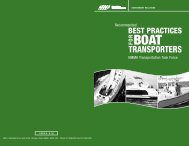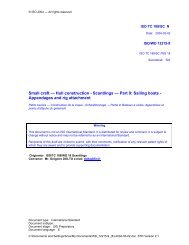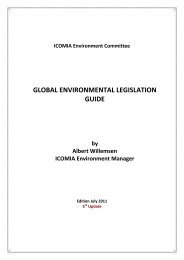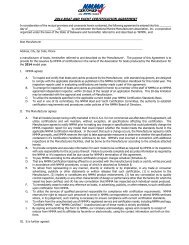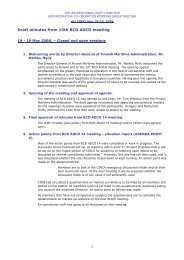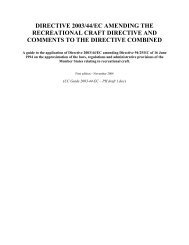Intellectual Property Protection and Enforcement Manual - Ipr-policy.eu
Intellectual Property Protection and Enforcement Manual - Ipr-policy.eu
Intellectual Property Protection and Enforcement Manual - Ipr-policy.eu
You also want an ePaper? Increase the reach of your titles
YUMPU automatically turns print PDFs into web optimized ePapers that Google loves.
ownership expires in less than 20 years, recordation will remain in effect until the ownership expires.<br />
If the ownership has not expired after 20 years, recordation can be renewed.<br />
Once the copyright is recorded, “piratical” articles, that is, copies or phonorecords that are made<br />
without the authorization of the copyright owner, are then denied entry by CBP <strong>and</strong> are subject<br />
to forfeiture as prohibited imports. Suspect goods may be detained by CBP, <strong>and</strong> the importer will<br />
be notified <strong>and</strong> advised that it may file a statement denying that the article is in fact an infringing<br />
copy <strong>and</strong> alleging that the detention of the article will result in a material depreciation of its value<br />
or a loss or damage to the company. If the importer does not file such a statement within 30 days,<br />
the suspect goods will be considered infringing copies <strong>and</strong> be subject to seizure <strong>and</strong> forfeiture. This<br />
procedure involves the constitutionally required notice <strong>and</strong> hearing elements for any administrative<br />
adjudication. Upon notice, the importer of the pirated goods has the opportunity to petition for relief<br />
from the forfeiture. If the importer fails to obtain such relief, the goods are disposed of by CBP.<br />
CBP, in the course of examining imported goods, may provide a sample of the suspect merch<strong>and</strong>ise<br />
to the copyright owner for examination, testing, or any other use in pursuit of a related private civil<br />
remedy for copyright infringement, provided that the copyright owner furnishes a bond holding CBP<br />
harmless from any loss or damage resulting from the furnishing of the sample.<br />
Laws Protecting Your <strong>Intellectual</strong> <strong>Property</strong><br />
Under the United States’ system of federalism, governing is shared between the state <strong>and</strong> federal<br />
governments. In other words, there may be laws at both the state <strong>and</strong> federal levels that are intended<br />
to address the same issues. At the same time, the uncodified, or so-called common law, may provide<br />
additional protections, at least with respect to civil actions. As it pertains to trademarks, this means<br />
that trademarks are protected under federal law <strong>and</strong> may also be protected under state law through<br />
state anti-counterfeiting statutes, trademark infringement or anti-dilution laws, or unfair trade<br />
practices <strong>and</strong> consumer protection laws. In contrast, with very limited exceptions, the U.S. Copyright<br />
Act expressly preempted all state <strong>and</strong> common law protections for copyright.<br />
While this manual focuses on the protections available at the federal level with respect to both<br />
criminal <strong>and</strong> civil proceedings, you should keep in mind that additional trademark protections may<br />
exist at the state level.<br />
Federal Civil Trademark Laws<br />
The primary way a trademark owner may enforce its rights is by bringing suit against alleged<br />
trademark infringers. The Lanham Act of 1946 created the federal statute governing trademark<br />
infringement. Under this act, the key statutory elements of trademark infringement are use in<br />
commerce <strong>and</strong> likelihood of confusion. Use in commerce generally requires the sale, or at least the<br />
importation or other shipment, of goods bearing the infringing trademark. 22<br />
Page 8<br />
Under the Lanham Act, a successful plaintiff can receive (1) injunctive relief, (2) the defendant’s<br />
profits, (3) any damages sustained by the plaintiff, <strong>and</strong> (4) the costs of the action. Moreover, in cases



